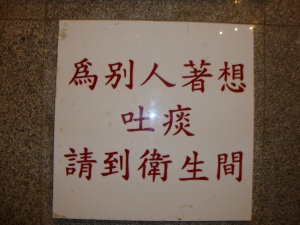A couple of weeks ago I was in a hotel in Mandalay, Burma when I noticed this sign near the elevator. It says that when spitting up phlegm, one should do so in the restroom (literally, the “sanitary room”), “out of consideration for others.”
As one can see, this sign is in Chinese. There were no other signs there in the hotel in any other language telling people not to spit in the hotel lobby.
As I stood there looking at the sign, a Chinese man walked by me, hacking up phlegm as he passed, and spit into the garbage can next to the elevator, right in front of a Burmese hotel employee.
What does this have to do with Southeast Asian history? I’m not sure,and maybe I’m being biased here, but somehow I feel like I was able to see some aspect of the historical relations between “China” and “Southeast Asia” (to use those terms anachronistically) at that moment.
The Burmese, traditionally referred to by the Chinese as “Southwestern Barbarians” (Xinan Yi), telling the Chinese not to spit, and the Chinese, with their 5,000 years of “civilization,” paying no attention. . .
Is there nothing symbolic of the past in that?

The Chinese seem to have ascended to the summit of the world’s ugliest tourists. You might be interested in another account in Vietnamese about the Chinese as travelers in Africa.
http://www.lungvu.com/2012/04/chuyen-bay-gio-moi-ke.html
He describes the behavior of Chinese laborers working in Africa. This problem probably is ultimately a continuation of the process of “nhà quê ra tỉnh” (to borrow the title of Đoàn Thêm’s very interesting book) – or bumpkins coming out of the provinces. Chinese travelers have achieved a modest enough of a level of affluence to afford them the opportunity to visit and work in other developing countries. Although they have the means to travel they have not adapted their behavior to their changed circumstances.
It creates the interesting problem that you point out – the “barbarians” now excoriate the behavior of the “civilized.” As my Vietnamese friend’s blog puts it – “không ai đến Tàu để tìm văn minh” – nobody goes to China to look for civilization.
Recently I was watching some Chinese in a Starbucks in Bangkok’s Don Muang airport. It was chaos. No one was standing in line. It was only with great difficulty (and many hand gestures) that the two Thai girls working there succeeded in communicating and getting the orders. One of the two girls was clearly frustrated, but she did a good job of maintaining her cool (it was 6:30 in the morning though, so who knows what happened later in the day. . .).
Then a white guy walked in and there was a complete “culture change.” The two girls immediately went into “professional Starbucks mode.” They smiled, apologized to the guy for the fact that he had to wait a bit for the Chinese to get out of the way, and then went about doing their job efficiently. Everything was smooth and upbeat.
This made me wonder – was this “reverence of white people” (like what Singaporeans get criticized for all the time)? Or was it that the guy’s whiteness signaled to them that, unlike the Chinese whom the two girls had just served, he knew “Starbucks culture” and that because of this they were going to be able to do things smoothly?
I’m not sure. Maybe some anthropologist can research this for her/his phd. In any case, one thing for sure is that in at least the short term, Chinese tourists are going to make many other tourists (regardless of skin color) look good. And who knows, given how large the number of “nhà quê” are in China, they will “ra tỉnh” for many years to come.
I recently heard someone on TV say that by 2020 there will be 200 million outbound Chinese tourists every year. Clearly there is money to be made in catering to Chinese tourists. Somehow, however, I just can’t see myself cashing in on that bonanza. . .